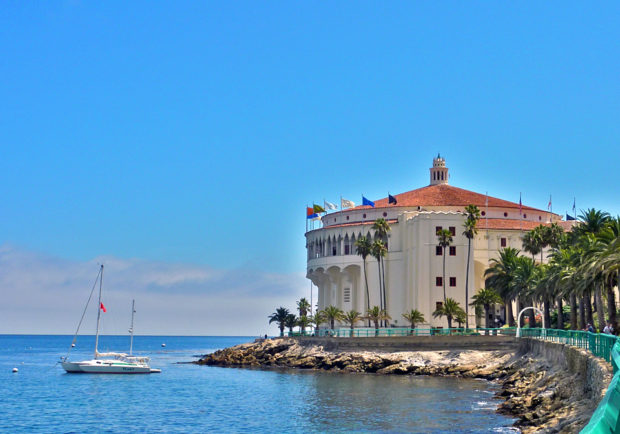One of the most recognizable landmarks of Catalina Island, just off the coast of Southern California, is the Catalina Casino.
It’s facade dominates the selection of postcards, souvenirs, and snapshots that visitors bring home from their Catalina trip. It’s unique circular design will be the first thing visitors notice when they enter the harbor at Avalon … and the last as they wave goodbye.
Wrigley’s Dream for the Catalina Casino
In 1919 William Wrigley Jr., of the famous chewing gum family, visited Catalina Island. He immediately fell in love with the scenic island and proceeded to buy up every share in the Santa Catalina Island Company. This move gave him controlling interest, and essentially made him the island’s “new owner.” He spent his life devoted to preserving and promoting the island and invested much of his own personal wealth to make it one of the country’s most unique island resorts.
The first dance pavilion that was built on the island was the Sugarloaf Casino. It soon proved to be too small and it was razed in 1928 to make way for the current building. Although it is named the Catalina Casino, it is not a place of gambling. The casino is named for the Italian word for gathering place, and was designed as a place for entertainment and dancing.
The structure took 14 months to build and was designed in the Moorish Alhambra style with Art Deco fixtures. It is a circular structure equivalent to twelve stories tall and is surrounded by water on by three sides. At Mr. Wrigley’s request the building was designed with a movie theatre on the lower level and a ballroom above it.
Catalina Casino Theatre
Entering the Catalina Casino Theatre it is hard not to be overwhelmed by the overall lavish design and attention to detail. The soaring ceiling is covered in over 60,000 individual squares of silver leaf and is inset with pin pricks of light to evoke the night- time sky. John Gabriel Beckham was commissioned to create the muralsthat adorn the walls of the theatre and the entrance to the foyer. He is best known for his work at Mann’s Chinese Theatre in Hollywood. He employed the island’s natural landscape and underwater motifs to create the spectacular murals that visitors see today. The murals designed for the outdoor area were re-executed in 1986, using tile pieces by artist Richard Keit.
An enormous Page Pipe Organ was installed in the theatre in order to accompany silent films that were being shown. It is one of only four working Page Organs in the world today, and is still used for concerts and as an intro to movie screenings.
Catalina Casino Ballroom
The famous ballroom is the world’s largest circular ballroom. It was designed in the height of elegance with muted coral colored walls soaring up to fifty-foot ceilings adorned with sparkling Tiffany chandeliers. The enormous dance floor is 180 ft. in diameter and is a combination of Maple, White Oak, and Rosewood. Elegant french doors encircle the room leading out to balconies that overlook the water. An elevated stage provided the venue for a variety of big bands that performed during the 1930’s – 1950’s, including Benny Goodman’s orchestra. Nightly big band radio broadcasts from the ballroom during this era introduced the nation to Catalina Island and it’s spectacular casino. Not to be missed is the vintage full scale bar in the back of the room.
Visiting the Catalina Casino Today
The Casino is an easy walk or trolley ride from downtown Avalon. Just walk through town and follow Via Casino Way. The Casino has been completely restored to it’s original grandeur and is open for tours daily. The theatre shows first run films on weekend evenings and the ballroom is still used for parties and concerts. There is also a small, but extensive museum located on the ground floor. More information on times and prices can be found on the Santa Catalina Company website.






